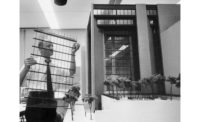Nearly two decades ago, the Metropolitan Museum of Art completed the 1970 master plan by Kevin Roche, FAIA, of Kevin Roche John Dinkeloo and Associates (KRJDA), for its building in New York City’s Central Park. Since then, the museum may not expand up or out on its site. Yet it continues to reconfigure interior spaces to accommodate changing curatorial needs and increased attendance. The latest installment in this ongoing process, the second phase of a three-part renovation of the museum’s American Wing, was unveiled on May 18 in a ribbon-cutting ceremony presided over by First Lady Michelle Obama
This stage of the project—by Roche, with the assistance of Garry Leonard, AIA, a senior design associate at KRJDA, and managing partner James P. Owens, Jr., AIA, in close collaboration with the Met’s curatorial staff—focused on the wing’s historic period rooms and glass-enclosed Charles Engelhard Court. It has transformed the erstwhile garden atrium into an exhibition hall by removing planters and replacing a formerly sunken, mason granite floor with a level Jerusalem limestone surface for the installation of sculpture. A new mezzanine was added under the balcony on the Central Park side of the court to display decorative arts, and the ground beneath it was excavated to provide 9,500 square feet of much-needed service space. The period rooms, which span the 17th through the early 20th century, were revised and reorganized for better chronological order and a clearer historical narrative.
When it opened in 1924, the American Wing—designed by architect Grosvenor Atterbury—was a freestanding, three-story structure to the northwest of the Met’s main building. Set behind the facade of Martin E. Thompson’s 1824 U.S. Branch Bank, which was acquired by the museum in 1915 when the former Wall Street building was razed, the wing was created to show American decorative arts and design, and featured a group of period rooms that would grow to become the most comprehensive collection of its kind in the world. In 1980, Roche expanded the wing according to his master plan to include painting and sculpture, and incorporated it into the main body of the museum with the addition of the Engelhard Court. At that time, a number of structural problems became evident that haunt the building to this day, chief among them the fact that its floor levels are out of sync with the rest of the museum.
Before the opening of the refurbished galleries, I spoke with Roche and Morrison H. Heckscher, chairman of the American Wing, about some of the challenges, as well as the history and achievements, of this project, and the delicate balance between architecture and art that such a program entails.
Leslie Yudell: Could you talk about the controversy that surrounded the expansion of the American Wing into Central Park in 1980?
Morrison Heckscher: At that time, the principal goal was to get the building built. The project was very political; it involved major negotiation having to do with building in the park. The design went forward regardless of the merits.
Kevin Roche: We had a hard time getting the master plan approved because the community said we were encroaching on Central Park, but we were not. The museum had been deeded a large area of the park, to the north, south, and west, that was never built up. Actually, we didn’t build out to the deeded area; we occupied less than the allotted space and gave back territory. The real issue for the community was they didn’t want the museum to expand at all.
LY: When the Engelhard Court finally opened in 1980, it was praised for its lush garden interior, and it remained popular. Why did you redesign it?
MH: The environment for plants is different than that for art, and after 30 years of experience with the building, we concluded that we could not maintain the space as a greenhouse. This is an art museum: It’s more important to have the collections displayed properly. Sculpture and stained glass especially were not shown to best effect.
KR: The Engelhard Court was never envisioned to have sculpture; it was intended as a garden courtyard. The design goes back to the original concept for the master plan, which introduced a series of relaxing places in the museum where people could rest, which would serve as entry points to different collections. The idea was borrowed from the courtyard of the Isabella Stewart Gardner Museum in Boston [by Willard T. Sears, 1901]. But as the sculpture collection grew, and pieces were moved from other areas into the court, I said: If this is an exhibition space, why not take out the plantings, level the floor, and make it a sculpture gallery.










Post a comment to this article
Report Abusive Comment